Construction
AI Compliance Agent for Construction: Automating HSE and Regulatory Compliance
October 22, 2025 • 88 Views • 25 min read
Tetiana Stoyko
CTO & Co-Founder
Construction compliance is notoriously complex. From Health, Safety, and Environment (HSE) mandates to stringent documentation, site tracking, and audit. Mistakes, delays, or transgressions in compliance can lead to costly fines, site closure, damage to reputation, and, most critically, accidents or injuries on the job.
Much of the compliance burden stems from manual labor. Fortunately, AI compliance agent solutions can help resolve this issue.
These solutions are autonomous or semi-autonomous software agents that utilize countless technologies to automate operations related to compliance. It includes machine learning, natural language processing, automation, and real-time monitoring to enforce, monitor, and facilitate compliance remotely.
By integrating compliance logic into workflow and linking it with sensor data, AI-driven agents can significantly reduce human labor, identify gaps early, and maintain audit-ready records at all times.
In this article, we delve into the world of construction compliance AI and explore how AI compliance agents can revolutionize compliance management in the construction industry, particularly in the fields of HSE and regulatory compliance automation.
The Growing Demand for Construction Compliance Automation
The number of compliance-related processes in the construction industry is nearly limitless. Furthermore, the number of such operations continues to increase. Among the latest issues are:
- Growing regulatory pressure, needs, and risks
- Demand for real-time management, tracking, and reporting
Growing Regulatory Pressure, ESG Needs, and Risks of Exposure
Construction is a regulated sector. Safety requirements evolve, environmental regulations tighten, and reporting becomes more prevalent across jurisdictions. Some projects require ESG disclosures based on safety performance, emissions, waste, or workers' health.
In such a setting, construction companies must adopt more stringent construction compliance management to avoid fines, project delays, or forfeited contracts. The number of requirements renders manual monitoring increasingly impracticable.
Construction compliance AI business automation can help to reduce the burden and streamline many aspects of this routine. Yet, it is essential to ensure the efficiency, accuracy, and legitimacy of such tools before they are integrated.
Demand for Real-Time Monitoring and Reporting
Stakeholders are increasingly demanding live dashboards and transparency, rather than snapshots at irregular intervals. Traditional reporting cycles (week, month) are too slow to detect issues in advance. The field desperately needs new approaches to compliance management for construction.
Large management systems are already utilizing AI-enabled safety solutions. For example, American contractor Shawmut Design and Construction, with over 150 job sites and ~30,000 workers, is using artificial intelligence to monitor worker behavior, anticipate safety incidents, and enforce compliance systems. Their experience attests to the business and safety benefits of AI construction safety systems.
So, what are construction compliance AI solutions, and how can they bring benefits to your business?
What Is an AI Compliance Agent?
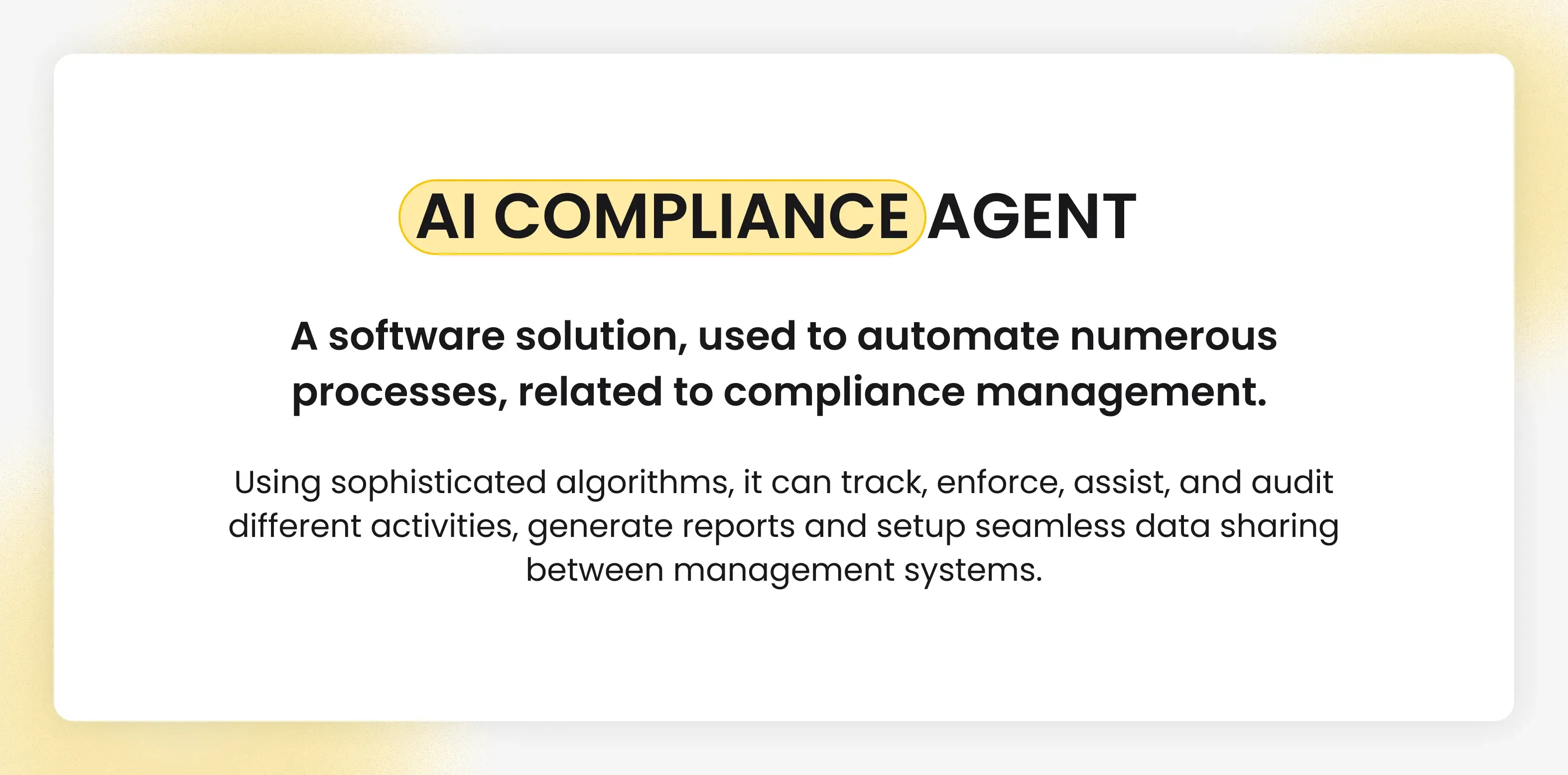
In brief, a construction compliance AI model is a semi-autonomous software agent that can perform pre-designed actions. It can monitor, enforce, assist, and audit compliance activities using artificial intelligence techniques.
In a building environment, such an agent processes data from various sources (documents, site sensors, SIM cards, wearables, field logs), performs rules, learns from patterns, and acts or alerts when compliance gaps exist. Simply put, an AI compliance agent is a "digital sentinel" that patrols compliance logic throughout the life of a construction project.
To enable such functionality, AI agents for compliance use different technologies. Still, the most famous and influential are machine learning, natural language processing, process automation, and computer vision.
-
Machine Learning (ML): the system will learn patterns of compliance, infer anomalies, and forecast risk from historical data (incident logs, inspection records, weather, worker movement).
-
Natural Language Processing (NLP): AI can read and interpret regulatory documents, permit text, safety notices, and site logs. It can identify discrepancies (e.g., field practice vs. permit conditions).
-
Rule Engines and Workflow Automation: rules of compliance (e.g., "inspect every 7 days," "report incidents within 24h") are programmed. Artificial intelligence checks documents, reminders, escalations, and audit exports.
-
Computer Vision and Sensor Analytics: Through cameras, drones, point cloud data, or IoT sensors, software can examine site photos/videos to detect hazards, scaffold deficiencies, the absence of PPE, structural irregularities, or environmental irregularities.
Difference Between Assistants, Monitoring Tools, and Agentic Systems
If you have ever considered construction project management software development related to artificial intelligence, you may have encountered a variety of different AI solutions. To reduce confusion, here is a brief explanation of the core software types within construction compliance:
-
AI-powered assistants function more as aid tools. For instance, they can assist in generating a compliance report or answering regulatory queries.
-
AI-powered compliance monitoring solutions are quiet observers. They can track and identify compliance issues and provide dashboards or alerts, but typically not forceful intervention or independent action.
-
AI compliance agents are fully autonomous models with advanced features. They can incorporate monitoring, decision-making, intervention, and continuous learning. Such solutions proactively escalate issues, enforce checks, and adapt compliance strategies over time, thus achieving AI-driven regulatory compliance at a higher level.
Therefore, when discussing AI-driven compliance management for construction, the vision is to have agentic systems as proactive compliance guardians.
Key Functions of an AI Compliance Agent in Construction
Let us examine how a construction compliance AI operates.
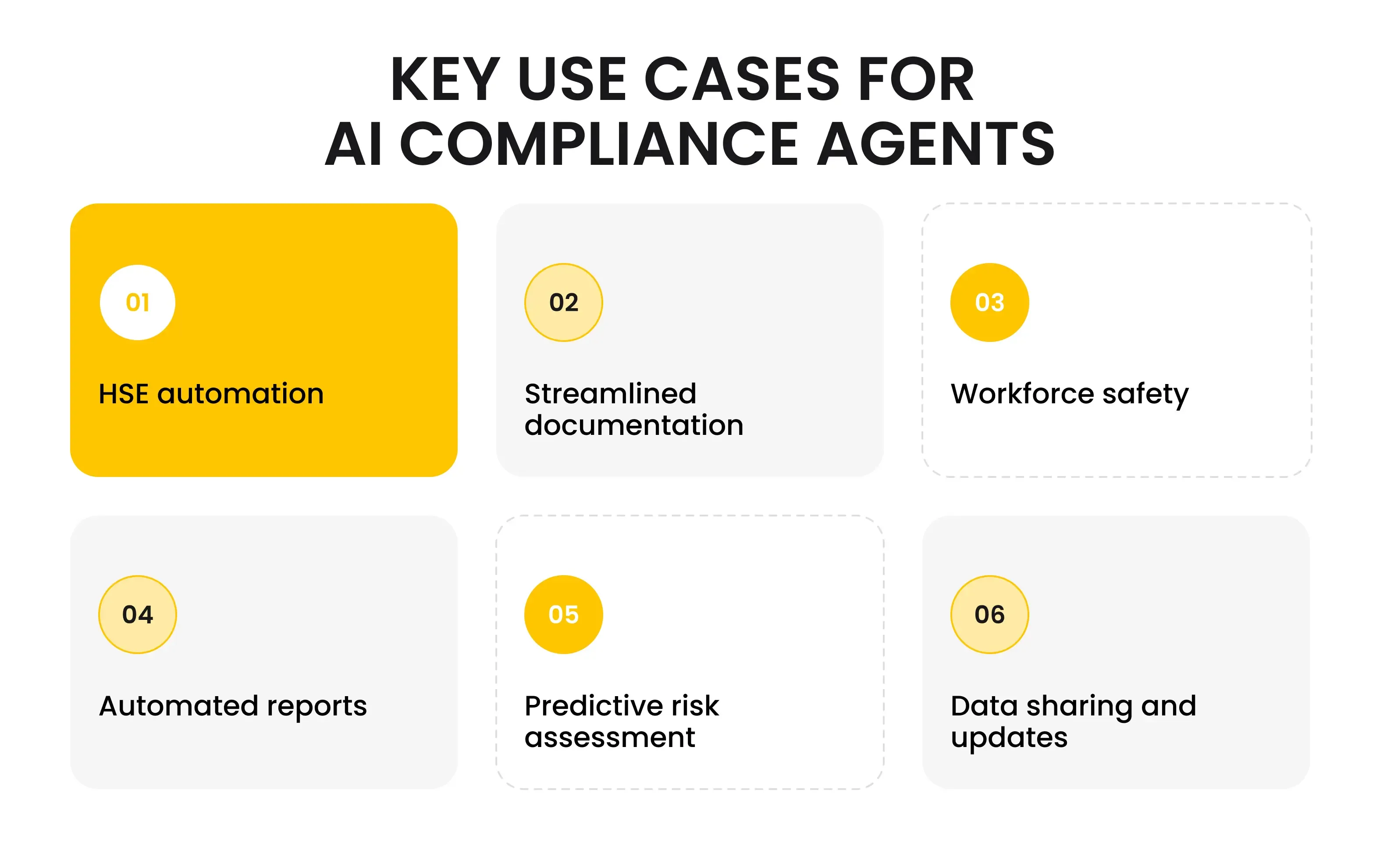
To effectively perform all these tasks and monitor compliance, these systems have to engage in as many operations as possible. Still, the most common and AI-suited processes include:
- HSE compliance automation
- Document and permit validation
- Workforce safety monitoring
- Automated reporting
- Predictive risk assessment
- Data updates and sharing
1. HSE Compliance Automation
These construction compliance monitoring systems convert safety regulations (scaffolding, fall protection, PPE, environmental limitations) into their rules engine.
They also continuously monitor accessed data, like site metrics, inspection records, and sensor inputs, initiating audits, alerts, or shutdowns whenever parameters deviate. For example, if air particulates exceed acceptable levels or a scaffold is improperly erected, the agent signals a deviation.
2. Document and Permit Validation
One of the most challenging tasks is confirming that permits, certification, insurance papers, or subcontractor records are current and in good standing.
Advanced construction compliance AI agents can analyze submitted documentation using numerous tools and practices. Among the most powerful ones are NLP, cross-reference against regulatory databases, and highlight inconsistencies or pending renewals.
VelocityEHS's AI add-on, for example, accelerates contractor document verification and preserves audit trails.
3. Workforce Safety Monitoring
Frankly, this service is highly dependent on third-party devices.
By combining data from multiple sources, such as site cameras, various sensors, or even personal devices, AI-based compliance management for construction enables the prevention of tragedies and provides advanced analytics on multiple metrics or workers' misbehavior.
Fortunately, your company won’t need to spend a fortune on extra devices; even a personal mobile phone with a downloaded application could be enough to significantly improve employees’ and construction site safety.
4. Automated Incident Reporting and Root-Cause Analysis
AI construction compliance monitoring solutions can easily file a report when incidents - or near-misses do occur.
Such reports might be even more detailed and valuable than those created by humans: AI can generate forms, collect metadata, trigger investigations, assign remediation measures, and track resolution. And all of this in under a few minutes!
Besides, it can utilize safety data analysis to identify causes and recurring patterns and recommend preventive measures.
5. Predictive Compliance Risk Assessment
Through the use of historic incident reports, sensor history, weather trends, and employee tendencies, the AI compliance monitoring agent learns likely risk locations or high-likelihood noncompliance.
As a result, AI in risk and compliance can help prevent risks and support organizations in forecasting potential pitfalls or pain points that warrant attention. As a result, companies can fix issues in advance, significantly reducing the risks or drawbacks.
6. Alerts, Dashboards, and Audit Preparation
Finally, an AI-powered compliance monitoring agent can be used to regularly update stakeholder dashboards, displaying the latest or most important information.
It can show open compliance gaps, trends, permits that are about to expire, areas at risk, and new alerts. Such solutions in regulatory compliance can also assemble audit-ready packages, including timestamped logs, evidence, and histories of corrections, on request to support regulatory inspections or internal audits.
Key Benefits and Advantages of AI in Regulatory Compliance
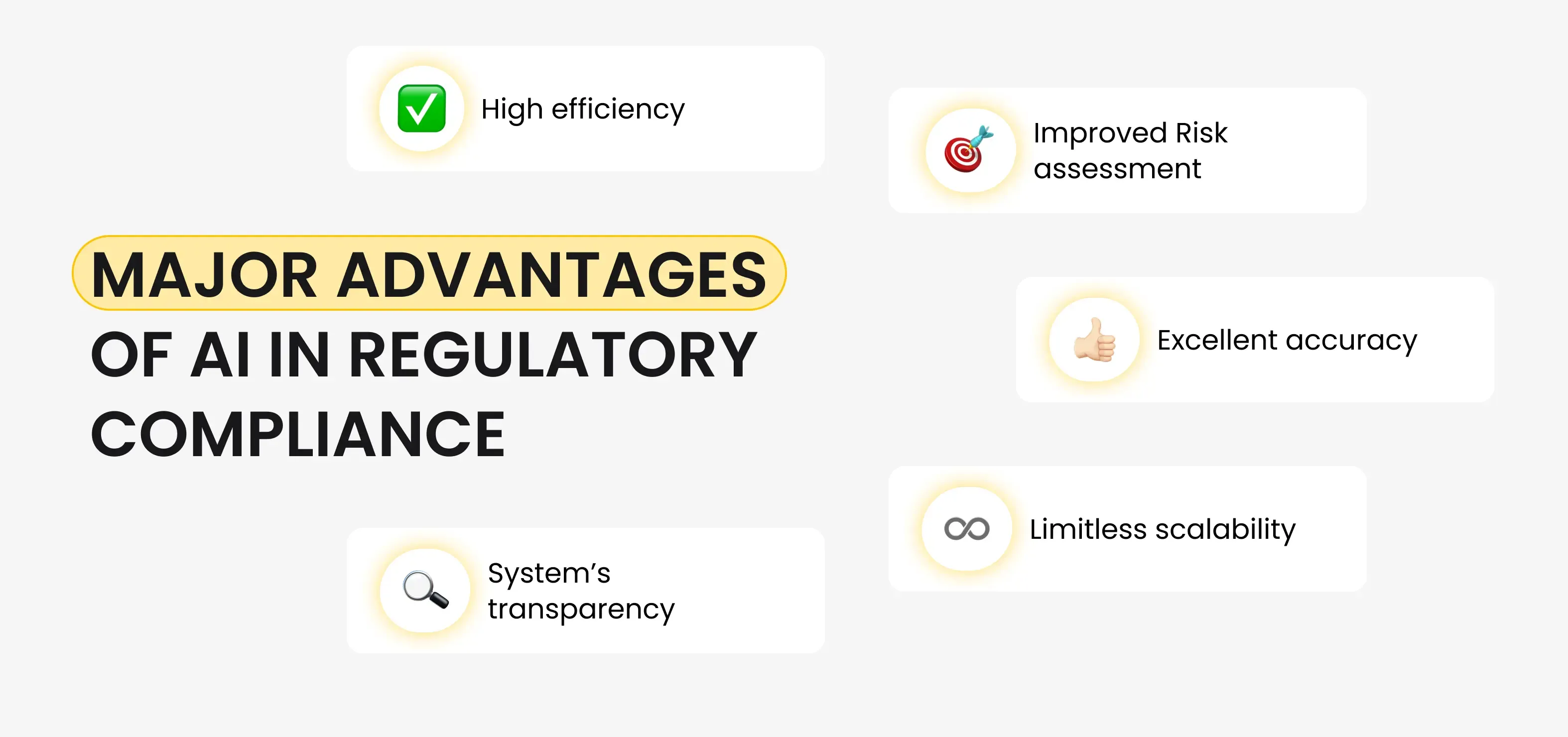
Having intelligently designed construction project management software with a built-in AI compliance agent offers a range of benefits. Here is another breakdown of how such compliance process automation brings actual benefits:
- Improved Efficiency
- Higher accuracy
- Better risk management
- Enhanced transparency
- Limitless scalability
Efficiency: Running Routine Compliance Checks Automatically
Routine compliance checks, such as inspections, permit renewals, and document reviews, consume a significant portion of staff time.
With AI compliance monitoring, most of these tasks run automatically in the background or according to schedule, allowing safety professionals and project managers to focus on more valuable work.
Accuracy: Removing Human Error and Inconsistency
Typical issues include human data entry errors, versioning conflicts, lost updates, or missing logs. An automatic system reduces discrepancies, all rules are enforced consistently, and omissions are identified and addressed.
Because it's rule-based and data-driven, the AI compliance management system is less likely to be overlooked.
Proactive Risk Management: Predictive Insights
Instead of reacting to incidents, the system enables AI-driven risk and compliance by alerting teams before violations occur. Prediction models help allocate resources to the riskiest domains. This leads to safer sites and surprises.
Cost Savings: Steer Clear of Administrative Overhead and Penalties
By reducing manual work, preventing safety incidents, and avoiding fines or shutdowns, the ROI can be substantial. In high-risk industries, for example, reviewing can significantly reduce bottlenecks and backlogs in compliance (VelocityEHS claims 7 times faster reviews).
Transparency: Real-Time Compliance Dashboards
Real-time insight into compliance performance is valued by executives, owners, and stakeholders. Such AI-powered systems provide situational awareness by location, subcontractor, and risk metrics, fostering better accountability and trust.
In addition to providing real-time insights, these systems also offer advanced analytics and detailed information to support informed decisions and informed assumptions.
Scalability: Multi-Site and Subcontractor Coverage
Construction firms often expand to multiple sites or have numerous subcontractors, making consistency difficult to maintain. A construction compliance AI scales well, enforcing uniform rules geographically and across contractors.
Therefore, businesses can utilize the same model for managing multiple sites or subcontractors simultaneously, with minimal adjustments and redesigns.
Construction Compliance AI Challenges and Limitations
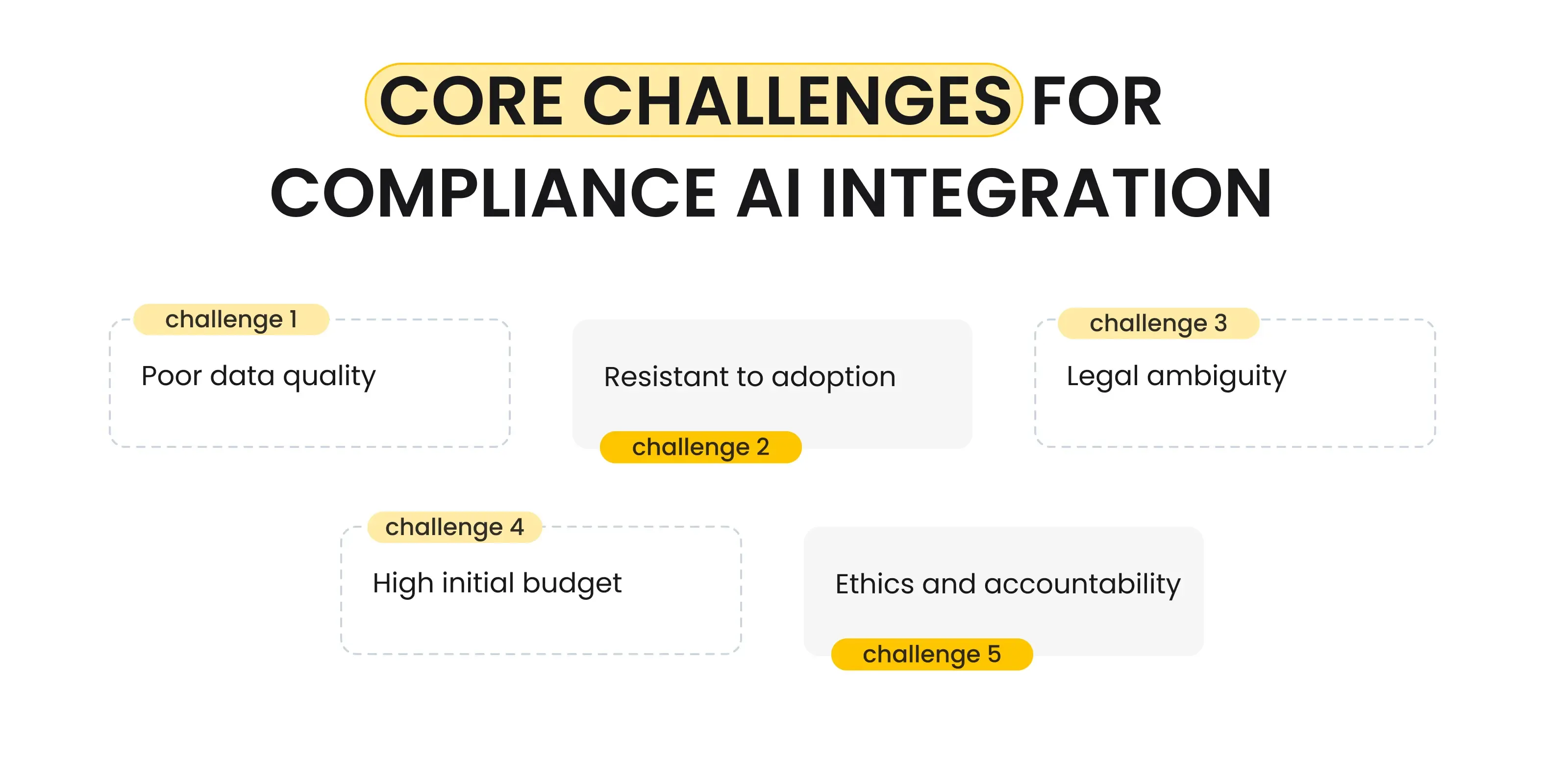
A balanced view involves considering the challenges in implementing AI compliance agents. Below are the key challenges and pitfalls to be aware of:
- Data quality and integration complexity
- Crew’s resistance to automation
- Ambiguity around generated reports
- Initial budget and need for training
- Ethics and accountability issues
Data Quality and Integration Complexity
Low-quality data (missing values, different formats, legacy systems) can weaken AI-powered compliance monitoring model accuracy and reliability. Integrating across various systems and having consistent data pipelines is typically one of the more difficult workstreams.
Resistance to Automation in Field Environments
Construction site work crews are cautious of new technology, viewing it as a form of micromanagement or surveillance. If on-site teams won’t adopt the software, it will compromise the overall AI’s efficiency. Effective change management, training, and honest alignment with worker safety are necessary for successful implementation.
Regulatory Ambiguity Around AI-Generated Reports
AI in regulatory compliance remains undefined. Regulators in most jurisdictions may not yet fully accept AI-generated reports or even question their admissibility or responsibility.
If an AI compliance agent identifies a compliance gap and the company disputes it, liability and defensibility will depend on the system's traceability, explainability, and the presence of audit trails.
Implementation Costs and Training Requirements
Its upfront deployment can be costly: system integration, model development, user education, rule tailoring per jurisdiction, and hardware/sensor deployment. To small contractors, upfront capital can be a stumbling block.
At the same time, even the most minor teams can afford a cheaper and simpler AI-driven solution, using it to streamline fewer operations. Besides, despite high initial costs, such agentic software shows excellent efficiency and ROI in the long run.
Ethical and Accountability Considerations
As autonomous flagging or even blocking occurs, the following questions arise:
Who is responsible when the system makes an error? How to deal with false positives that lock good work? How to keep bias or blind spots (e.g., atypical site conditions) from confusing the system?
Open governance, human monitoring, fallback modes, and stringent validation frameworks are essential. In other words, even though agentic AI can be delegated with decision-making, the final approval must be made by a human specialist.
Limitations of AI and LLMs
Recent research shows that LLMs like GPT-4 and GPT-3.5, when used in safety or compliance situations, can exhibit errors in reasoning, memory lapses, or mathematical errors, especially where they have been less thoroughly tested.
Over-reliance on AI predictions that a human has not verified can be dangerous; therefore, safety-critical decisions must still be human-checked until the system's trust is firmly established.
Future of AI in Construction Compliance
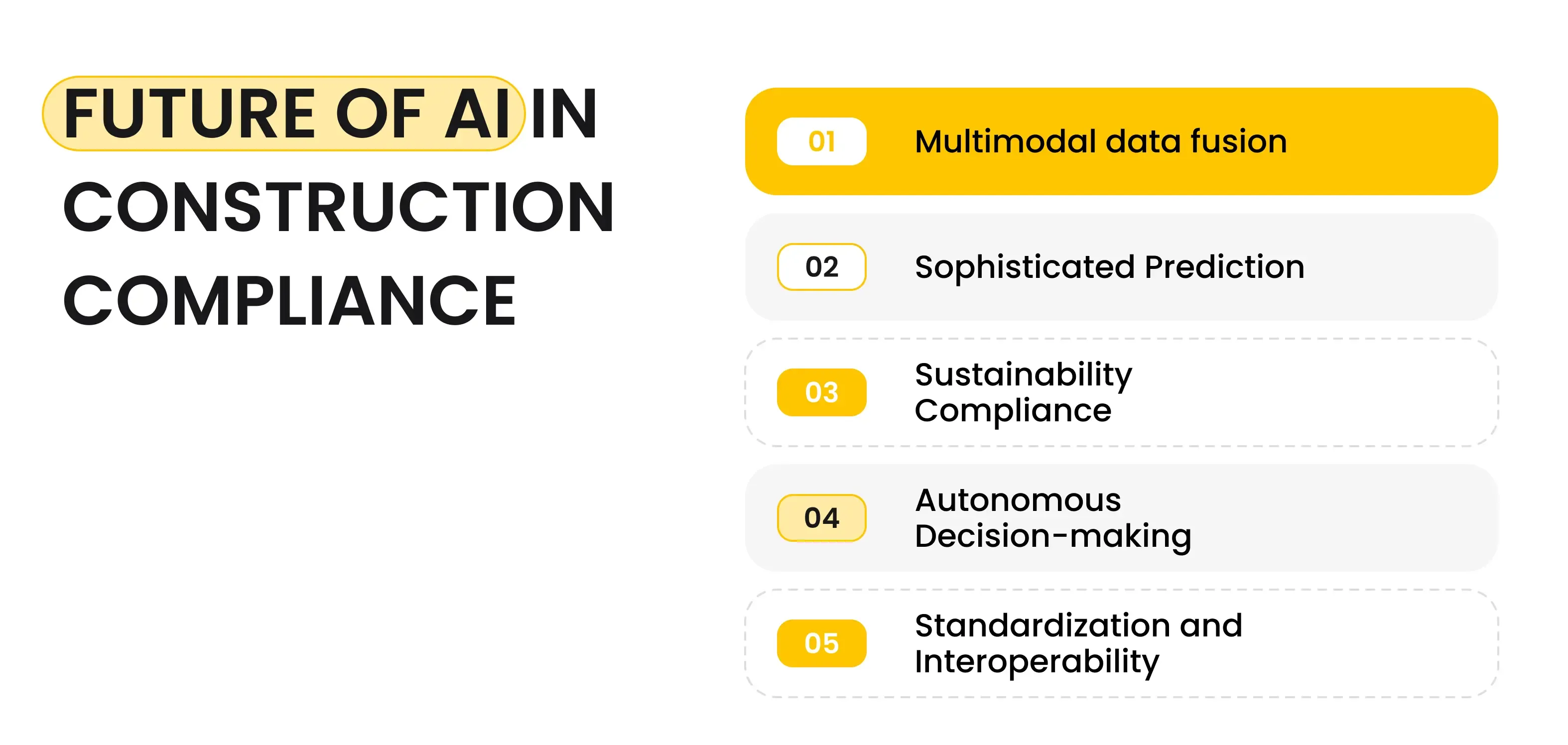
Generative AI and Multimodal Data Fusion
With generative AI and large models becoming ever more mature, AI compliance agents will generate narrative summaries of compliance performance, provide open-ended responses ("Will this permit clause conflict with the newest regulation?"), and integrate text, image, video, and sensor data into synthesized conclusions.
Multimodal inputs (video, sensor logs, weather, and contracts) will enable a richer compliance context, allowing the agent to detect minor transgressions (e.g., environmental spill risk in conjunction with soil moisture).
More Sophisticated Predictive Models
The future agents will be founded on more advanced forecasting: probabilistic risk modeling, scenario simulation (what-if), cross-site data learning, and dynamically adapting compliance thresholds as a function of performance.
This represents the cutting edge of AI for risk and compliance in the construction industry and beyond.
Integration with ESG and Sustainability Compliance
Compliance for construction will not only touch safety but also environmental, social, and governance (ESG) compliance. AI compliance agents will monitor emissions, waste, carbon reporting, biodiversity footprint, and social metrics.
The compliance base will expand, and agents will consolidate HSE, construction compliance reporting, and ESG into one dashboard.
Autonomous Safety Decision-Making and Closed-Loop Control
On the boundary, AI-driven compliance process automation agents may independently enforce safety decisions, such as stopping equipment, restricting access to high-risk areas, adjusting schedules based on risk situations, or dynamically re-routing work. It's an extension towards autonomous AI-based compliance monitoring with direct control of site operations.
Standardization, Interoperability, and Compliance Protocols
With growing adoption, regulatory agencies can establish compliance data standards or APIs, enabling machines to authenticate with each other. In other words, agents connect directly to corporate systems, authenticate automatically, check for compliance, and submit audits easily (much like RegTech in banking). The compliance automation revolution is already well underway in more advanced industries.
AI Compliance Agent Development with Incora
The construction industry, which has long struggled with fragmented systems, manual-based compliance, and high-risk stakes, stands at the threshold of transformation. Compliance AI agents offer a compelling approach to automating day-to-day processes, thereby reducing risk, enhancing transparency, and fostering a proactive safety culture.
Challenges abound (data quality, adoption resistance, regulatory buy-in, accountability), but the benefits are compelling: efficiency gains, enhanced accuracy, foretelling risk insight, cost savings, scalable compliance, and real-time dashboards.
Here, at Incora, we know how to make AI compliance agents and successfully integrate them within the business of any scale. By leveraging and combining knowledge from our previous projects, we refine our vision and expertise in industry-specific artificial intelligence, identifying new and more efficient approaches and solutions for various problems, including compliance management and monitoring.
So, if compliance issues are weighing down your business, or you're seeking a competitive edge in safety and risk control, the time to introduce AI agents for compliance and create the future of AI in regulatory compliance in construction is now. Contact us now, and we will be happy to find a way to lighten your everyday burden.
What’s your impression after reading this?
Love it!
24
Valuable
17
Exciting
7
Unsatisfied
1
FAQ
Let us address your doubts and clarify key points from the article for better understanding.
What is an AI compliance agent for construction?
An AI compliance agent is a semi-autonomous software system that uses machine learning, natural language processing, and real-time monitoring to automate HSE (Health, Safety, and Environment) and regulatory compliance tasks in construction. It monitors, enforces, and audits compliance activities, reducing manual work and identifying gaps before they become issues.
How does AI compliance automation benefit construction companies?
Key benefits include improved efficiency through automated routine checks, higher accuracy by eliminating human error, proactive risk management with predictive insights, cost savings from avoiding fines and reducing administrative overhead, real-time compliance dashboards for transparency, and scalability across multiple sites and subcontractors.
What key functions do AI compliance agents perform?
AI compliance agents automate HSE compliance monitoring, validate documents and permits using NLP, monitor workforce safety through sensors and cameras, generate automated incident reports with root-cause analysis, provide predictive risk assessments, and maintain audit-ready records with real-time dashboards.
What are the main challenges in implementing AI compliance agents?
Challenges include data quality and integration complexity across legacy systems, resistance from field crews who may view it as surveillance, regulatory ambiguity around AI-generated reports, high implementation costs and training requirements, and ethical considerations around accountability when the system makes errors or false positives.
Do AI compliance agents replace human oversight?
No. While AI compliance agents automate routine tasks and provide predictive insights, human specialists must still make final approval decisions, especially for safety-critical situations. The systems are designed to assist and enhance human decision-making, not replace it entirely.
you may also like
Construction
AI Shift Scheduling for Construction: Is This the Future of HR and Payroll?
Management Systems
Construction Project Management Software for Small Business: Complete Guide
Construction
How AI Negotiation Agents Improve Construction Procurement [And Why Do You Need It]
Construction,
Real Estate
How Construction Workflow Management Software Helps to Reduce Costs and Boost Efficiency?
Construction
How Integrated BOQ Software Bridges the Gap Between Construction Departments
Construction
How to Create a Procore Alternative Software for a Construction Business
Construction
How to Deal With Weaknesses of Construction Financial Management Software?
Real Estate
How to Select the Right Construction Management Software for Your Business
Construction
Investing in the Right Construction Reporting Software: Features That Make a Difference
Construction
Is Voice Technology Worth the Investment for Construction Firms?
Construction
Overcoming Integration Challenges: Making Construction Data Work Together with BI Tools
Management Systems
Simple Construction Software for Construction Planning: Case Study
Construction
The Complete Guide to AI Construction Document Review for Project Management
Let’s talk!
This site uses cookies to improve your user experience. Read our Privacy Policy
Accept
Share this article